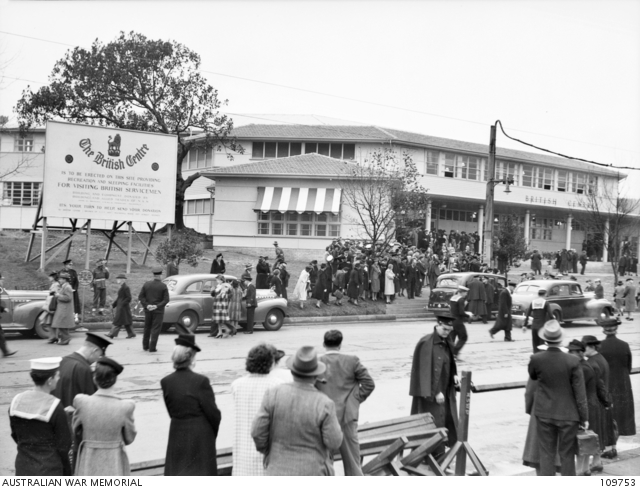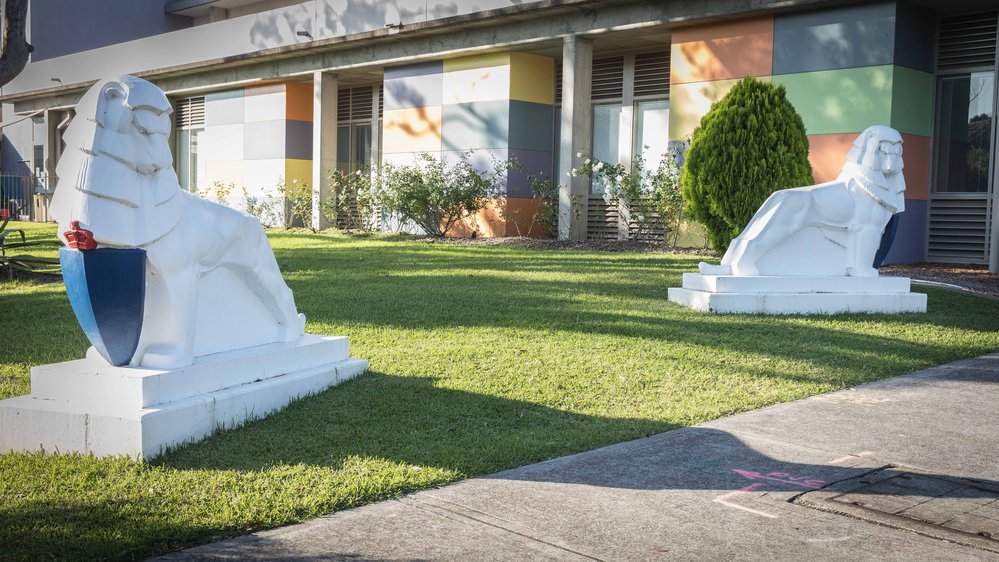- Author
- Editorial Staff
- Subjects
- History - WW2
- Tags
-
- RAN Ships
- None noted.
- Publication
- September 2022 edition of the Naval Historical Review (all rights reserved)
With thanks to Councillor Nathan Tilbury of the Hornsby Council, the Vice President of the Hornsby Historical Society, and a local paper The Bush Telegraph (February 2022) we are pleased to relate the following story.
The British Centre was originally erected at Hyde Park1, Sydney, opposite St Mary’s Cathedral. It was established to provide residential and recreational facilities for British service personnel who were on leave in Sydney during the Second World War, and it could accommodate up to 1400 men a night. Funds to establish the British Centre were raised by the Australian community during the war.
When the war ended on 2 September 1945, just a few months after the British Centre opened, it was suddenly not required. Hornsby Shire Councillor and Hospital Board member, Sid Storey, who was also the independent State MP for Hornsby, saw an opportunity and negotiated to buy the British Centre for the nominal amount of £1. He also organised for the building to be dismantled, with every piece carefully numbered, before it was transported to the Hornsby District Hospital grounds for just £8000. The British Centre was trucked to Hornsby in November 1946, with all the pieces carefully unloaded on the hospital grounds, ready to be re-assembled, with the intention of it becoming a convalescent unit for a number of hospitals stretching from the Royal North Shore to Parramatta.
Where the plan broke down was a misunderstanding as to who was responsible for the cost to re-erect the building, which was estimated to be around £20,000. For a long time, the State Government refused to contribute anything towards the re-assembly costs. After nearly a decade of the building sitting in a huge pile on the hospital grounds, funds were finally found to put the British Centre back together. By then the needs of the local area had changed and the building was opened as Hornsby Hospital’s first maternity unit, with 50 beds. On 16 September 1956, the facility was formally opened by the Governor of NSW, Sir John Northcott. The name, the British Centre, was retained to commemorate the role it played during WWII.

The reconstruction of this building included the two white concrete lions. These were set up out the front of the building to guard the entrance. The concrete lions became a well-known sight for locals, particularly many older siblings visiting the Hospital to see their new-born little brother or sister, only to become bored and head outside to climb the white lions.

Tens of thousands of local children were born in the British Centre at Hornsby Hospital. This building was demolished in 2010 to make way for the Mental Health Centre. However, the concrete lions were restored and relocated, and they continue to guard the hospital grounds today. But not a skerrick of information remains at Hyde Park to remind us of this remarkable feature of wartime Sydney.
Further Information on the building
Within the library of the Naval Historical Society a copy of the First Annual Report of The British Centre was located, which was noted as a Branch of the Australian Comforts Fund (NSW Division). The report was presented to the first annual meeting on 29 October 1945. This provides further information which is of significant interest when considering the logistical requirements involved in providing support to Allied servicemen based in Australia during WWII. This is especially true of the vast British Pacific Fleet (BPF) which came into being on 22 November 1944 comprising over 200 ships and submarines, together with 750 aircraft. At its peak the number of personnel was estimated at 125,000 plus 30,000 Australian support staff. While the aim of the BPF was to be self-sufficient this was never fully achieved.
The British Centre can be seen as part of the logistical support required to maintain the morale of British forces operating from our shores. The main facility at Hyde Park was supported by a number of auxiliary units providing limited accommodation and entertainment. These comprised: Macdonell House in Pitt Street, Navy Branch in Phillip Street, an officers’ club at Macquarie Street, another officers’ club at Kensington mainly catering for the Fleet Air Arm (FAA), with further offices at Bankstown (FAA), East Sydney, Katoomba, Manly, Mosman and Wollongong (FAA).
When it became apparent that British forces might be expected in the Pacific the Lord Major of Sydney, Alderman R.J. Bartley, convened a meeting on 27 October 1944 to invite suggestions from interested citizens as to the best way of obtaining help and assistance for the establishment of a British Centre. Shortly afterwards a portion of Macdonell House was made available through the Australian Comforts Fund, to handle initial inquiries and to form a committee for the establishment of a British Centre. Substantial donations were promised, permitting the committee to negotiate with Building and Allied Trades to build the hostel. The City Council made a site available in the very heart of the city.
The palatial British Centre in Hyde Park was however cleverly purpose-built as a demountable building which could in future be reused as a public amenity. The splendid design was drawn up by the architect Mr John R. Brogan and with good will, war-time building restrictions, material shortages and labour problems were overcome leaving Robert Wall & Sons to erect the mainly wooden structure quickly on a non-profit basis. Donations came freely from forests and sawmills of the state, glass makers, timber merchants, case manufacturers, locksmiths, builders, paint and wallboard manufacturers, cement companies, hardware distributors, electricity and gas suppliers, and every other activity connected with the building industry. Over £26,000 was raised in cash and kind. Just eight months after the initial public meeting the building was officially opened on 22 June 1945 by His Royal Highness the Duke of Gloucester.
Amenities
The hostel was designed to afford the maximum of comfort and was perhaps the largest and the best of its kind in the world. Two weeks before the official opening the Centre really came alive on 11 June 1945 when the famous songstress Gracie Fields performed in front of 4000 adoring servicemen. This was a resounding success.
The Great Hall was designed to accommodate over 3000 personnel (but as noted above this was exceeded) and there was a ballroom, which also doubled for concerts and picture shows. Every evening a full dance band of talented professional artists assisted with the entertainment. There was space to provide beds for 1400 men per night with hot and cold showers and over 1500 full three-course hot meals were served daily in the dining room. In addition, the Cafeteria and Snack Bars served up to 10,000 customers a day. A large modern library, reading rooms, writing rooms, billiard tables and games were well patronised. There was a hospitality centre, barber’s shop, buffet and milk bar and many other activities based in this great facility. There was even a First-Aid room which attracted about 30 patients per day, with the feminine touch of the duty nurse working wonders for speedy recovery.
One of our members, Marsden Hordern, now a centenarian, fondly recalls the British Centre as a large building surrounding a central courtyard which was decked out with a number of white canvas marquees, each marquee having a designated purpose. It allowed visitors to book short trips to the beach and the countryside where they were well looked after.
While the activities were intended for British other ranks, they were also frequented by Australians including junior officers. In the days before instant communications, where telephones were a luxury, it was possible to put your name down in a book to meet a member of the fair sex, and you might then be lucky in taking an attractive companion to the pictures.
There are some messages included as an addendum to the First Annual Report which pay tribute to the services rendered by the Centre. The C-in-C British Pacific Fleet, Admiral Sir Bruce Fraser says:
The British Pacific Fleet has indeed been fortunate in being based in Australia, where not only has it enjoyed the boundless and spontaneous hospitality for which that country is so justly renowned and which is typified by the efficient and never-failing friendly help of the British Centre, but also was privileged to fight in such close comradeship with the gallant sons of Australia, whose deeds on sea, land and in the air will live immortal in man’s memory.
Another comes from the First Lord of the Admiralty:
That the Board of Admiralty have learnt with much pleasure of the very fine work which has been carried out by The British Centre, Sydney, and that they desire to convey to the President and the Committee their grateful appreciation of the valuable amenity which contributes so much to the comfort and welfare of naval ratings.
And another from HRH The Duke of Gloucester, Governor-General of Australia whose Chief of Staff writes:
His Royal Highness asks me to say that he bears nothing but praise for the outstanding work which is being done for the Navy in The British Centre, and wishes me to congratulate you, your staff and workers on it.
Summary
These days we expend considerable effort in planning logistical requirements in keeping troops in the field and ships at sea. But the British Centre did this at another level where the citizens of the host nation, seeing a need to provide moral support and possibly keeping personnel out of trouble, banded together and provided a much-needed amenity for their guests. They also thought ahead, and knowing this was a transient phase used an imaginative design which could be re-adapted for another community purpose. Perhaps there are lessons to be learned from this now long forgotten experiment.
Notes:
Governor Macquarie named what had been ‘The Common’ in Sydney as Hyde Park after its namesake in London. In London the land once belonged to the Manor of Hyde which was seized from the Abby of Westminster by Henry VIII for a hunting reserve in 1536.




